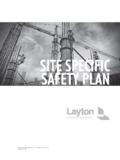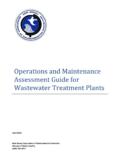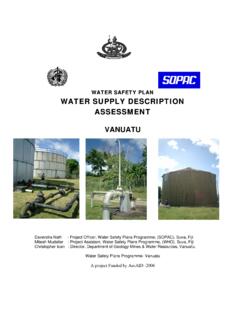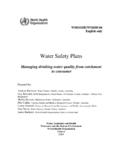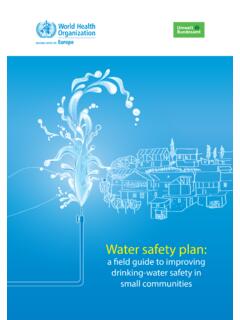Transcription of Water safety plans: methodologies for risk assessment and ...
1 1 Water safety plans: methodologies for risk assessment and risk management in drinking- Water systems JOS MANUEL PEREIRA VIEIRA Department of Civil Engineering, University of Minho, 4704-553, Braga, Portugal Abstract Providing good and safe drinking- Water is world-wide considered to be a fundamental political issue for public health protection, and must be the primary objective of Water supply systems. Drinking- Water quality control has currently been based on detection of pathogens and toxic concentrations of chemicals by means of monitoring programs and compliance with national or international guidelines and standards, relying mainly on indicator bacteria and chemicals maximum concentration levels.
2 However, this methodology is often slow, complex and costly. Even for sophisticated and well-operated systems these monitoring schemes have proved to be inefficient in preventing waterborne diseases like, for instance, Giardia or Cryptosporidium outbreaks. From this evidence we can conclude that end-product testing is a reactive rather than preventive way to demonstrate confidence in good and safe drinking- Water . This justifies the need for the formulation of a new approach in drinking- Water quality control based on understanding of system vulnerability for contamination and on preventive means and actions necessary to guarantee the safety of the Water supplied to the consumer.
3 Water safety plan is a concept for risk assessment and risk management throughout the Water cycle from the catchments to the point of consumption. This approach includes the identification of the hazards and introduction of control points that serve to minimize these potential hazards, providing for more effective control of drinking- Water quality. This paper presents an overview of the first two years experience in developing and implementing a Water safety plan in a Portuguese multi-municipal Water company. Since key personnel had contributed to the assessment of hazards and evaluation of corrective actions for control points, a greater understanding of Water quality control and improvements on technical operation and performance have been registered, demonstrating good value for the methodology.
4 Key Words drinking- Water quality, multiple barriers, risk management, source Water protection INTRODUCTION Drinking- Water quality control is a key issue in public health policies. Special attention and efforts were taken on surveillance and safety of Water supply systems after John Snow established, through epidemiological investigations, Water as major route of cholera transmission in London (Snow, 1855), Louis Pasteur (1863) discovered the existence of micro-organisms, and Robert Koch (1863) reported the detection methods of micro-organisms in Water . In the late 19th century, many countries in Europe and America started with new 2approaches of drinking- Water quality control, especially in high populated urban public systems, relying mainly on disinfection by chlorine for pathogen micro-organisms inactivation.
5 From 1950 to 1970 the World Health Organization (WHO) published standards for drinking- Water quality that served as a scientific basis for monitoring the quality of the Water produced and delivered by Water suppliers. Later on, other legislative and regulatory approaches were published by the WHO and the European Union (EU): WHO Guidelines for Drinking- Water (1st edition, 1984, and 2nd edition, 1993), and EU Directives 80/778/EC, and 98/83/EC (EC, 1998). This legislation was strongly focused on standards for treated drinking- Water and on compliance monitoring. Water quality was guaranteed by the so called end-product testing, based on spot sampling of the Water produced. With this procedure it was possible to bring the very widespread Water -borne diseases under control, especially those of bacterial origin.
6 Over the years, several shortcomings and limitations of the end-product testing methodology have been identified. Some of them are related to the following aspects: a) There is a multitude of Water -borne pathogens that cannot be detected or they can be detected insecurely with the classical indicators E. coli Coliforms and Enterococci, particularly viruses and protozoa. There are examples of Water -borne disease outbreaks ( , Millwaukee - , in 1993) that occurred through Water supply systems that met the standard for absence of indicator micro-organisms. b) Often, monitoring results are available out of time of intervention needed to maintain the safety of a supply system. End-product testing only allows checking if the Water delivered was good and safe (or unsafe) after distributed and consumed.
7 C) End-product testing hardly can be considered a sound method for representative Water quality status. A very small fraction of the total volume of Water produced and delivered is subject to microbiological and chemical analysis. Moreover, the monitoring frequency does not guarantee representative results in time and space, as well. 3d) End-product testing does not provide safety in itself. Rather is a mean of verification that all the supply system components and installed control measures are working properly. In recognition of these limitations, primary reliance on end-product testing is presently considered not to be sufficient to provide confidence in good and safe drinking- Water , moving towards to process monitoring by introducing a management framework for safe Water (Bartram et al.
8 , 2001). The 3rd edition of the WHO Guidelines for Drinking- Water Quality, (GDWQ) proposes a more effective risk assessment and risk management approach for drinking- Water quality control. The GDWQ emphasize the multi-barrier principle, establishing a systematic process for hazards identification and effective management procedures for their control through the application of a preventive Water safety plan (WSP) that comprises all steps in Water protection, from catchments to the consumer (2001; WHO, 2004). Water safety PLANS. A NEW RISK-BASED METHODOLOGY The methodology proposed in the GDWQ seeks to move away from sole reliance on end-product testing, which will be integrated into a control strategy for consistently ensuring the safety of a drinking- Water supply system, applying a comprehensive risk assessment and risk management approach.
9 For most large drinking- Water supplies some elements of WSP will often represent routine practice. This may include quality assurance systems ( , ISO 9001:2000). Major beneficiaries of this approach will be the small supplies (serving less than 5000 people) where end-product testing is often inadequate. Since a vast majority of the Water supplies in Europe are small, monitoring and controlling the Water quality of small Water supplies is a major issue throughout Europe. 4 The safety of drinking- Water depends on a number of factors, including quality of source Water , effectiveness of treatment and integrity of the distribution system. System-tailored hazard identification and risk assessment must be considered as a starting point for system management.
10 A generic flow diagram for risk assessment from catchment to customer is depicted in Fig. 1. Fig. 1 Generic flow diagram for risk assessment (Adapted from Stevens et al., 1995) The objective of the WSP is to supply Water of a quality that will allow health-based targets to be met. The success of the WSP is assessed through drinking- Water supply surveillance. The three key components of a WSP are: a) system assessment , which involves assessing the capability of the drinking- Water supply chain (from Water source to the point of consumption) to deliver Water of a quality that meets the identified targets, and assessing design criteria for new systems; b) identification of control measures in a drinking- Water system that will collectively control identified risks and ensure that health-based targets are met.




